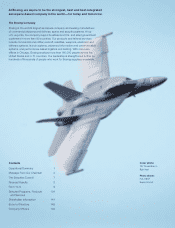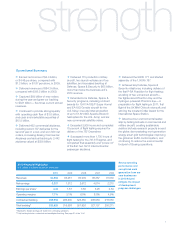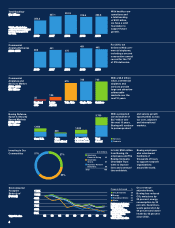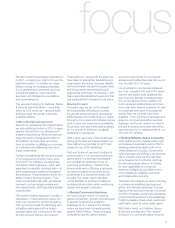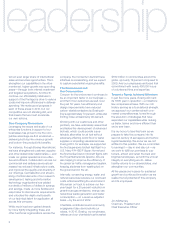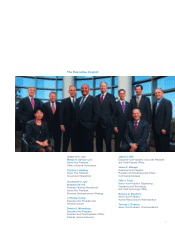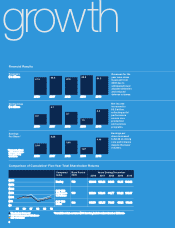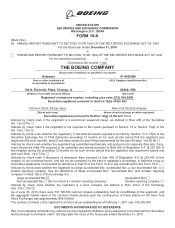Boeing 2010 Annual Report Download - page 5
Download and view the complete annual report
Please find page 5 of the 2010 Boeing annual report below. You can navigate through the pages in the report by either clicking on the pages listed below, or by using the keyword search tool below to find specific information within the annual report.3
innovation
innovation
We have built a strong foundation for
long-term leadership that combines five
critical elements:
QInnovation and technological leadership.
QAn unrelenting focus on productivity
to continuously fund our growth.
QGlobal scale and flexibility.
QEnterprise collaboration that leverages
the breadth and depth of our capabilities.
QA highly skilled and motivated em-
ployee team…with the toughness and
resiliency to overcome adversity, and a
willingness to learn from our mistakes.
2010 Review
Sustainable growth begins with ever-
increasing productivity in core businesses
—which provide the cash and earnings
needed to invest in innovation and the
development of the core businesses of
the future.
In 2010, our core production and ser-
vices programs in Boeing Commercial
Airplanes and Boeing Defense, Space
& Security performed exceptionally well,
leading to near-double-digit operating
margins in each of these businesses.
We ended the year with net earnings of
$3.3 billion (the second highest in com-
pany history), and our positive operating
cash flow of nearly $3.0 billion maintained
strong liquidity of $10.5 billion — all this
despite the impact of development pro-
gram challenges in both businesses and
budget pressures on defense programs.
Boeing Commercial Airplanes delivered
462 airplanes in 2010, including a record
376 Boeing 737s. As air traffic rebounded
strongly and the airline industry returned
to profitability, we added new orders for
530 airplanes (net of cancellations), more
than double the prior year’s total, and
revenue from commercial services grew
more than 11 percent for the year.
In response to this resurgent demand
from the world’s airlines, we announced a
series of production increases across our
product lines. The 737 production rate will
increase from 31.5 airplanes per month
to 35 in the beginning of 2012 and then
to 38 per month in the second quarter of
2013. Production of the widebody 777 is
slated to increase to more than eight per
month in the first quarter of 2013.
On the development side, we made
significant progress on flight testing of the
787 Dreamliner and the 747-8 Freighter,
completing three-quarters and two-thirds,
respectively, of the flight testing needed to
deliver the first airplanes. However, due to
discoveries made during that testing, we
postponed first deliveries of both models
until 2011. While our testing served its
purpose in identifying issues before our
products enter into service, we regret the
inconvenience and disappointment our
customers have experienced as a result.
Notwithstanding these delays, our confi-
dence in and enthusiasm for the game-
changing capabilities that these new
airplanes will bring to the world’s airlines
remains undiminished. Demand for the
787 has held exceptionally strong, with
847 firm orders from 57 customers in 37
countries at year end. Overall, we ended
2010 with a backlog of 3,443 firm com-
mercial airplane orders valued at $256 bil-
lion, which sets a remarkable foundation
for near-term and future growth.
Also in 2010, Boeing Defense, Space
& Security delivered 115 new and 66
remanufactured aircraft across tactical,
mobility and surveillance programs, along
with more than 10,000 precision-guided
weapons systems, two launch vehicles,
and four satellites. We also successfully
performed three Space Shuttle launches
and delivered performance-based logis-
tics to customers worldwide.
In a strong year for sales, new orders for
the group totaled $32 billion, including
contracts for a multiyear procurement of
124 F/A-18 and EA-18G aircraft for the
U.S. Navy; eight C-17s for the U.S. Air
Force; Apache and Chinook rotorcraft
for multiple customers; a satellite com-
munications system for the government
of Mexico; unmanned aircraft systems
contracts for the U.S. Air Force and
U.S. Navy; and a $1.1 billion contract to
provide the Future Logistics Information
Services system for the United Kingdom.
We also reached a key milestone with
Congressional approval of a multibillion-
dollar pending sale of F-15 fighters,
Apache helicopters, and other systems
to Saudi Arabia.
In addition, we had several developmen-
tal and technological “firsts.” Our X-51A
WaveRider, a hypersonic U.S. Air Force
research vehicle, reached Mach 5 during
its first flight—the longest supersonic
combustion ramjet flight in history. The
X-37B Orbital Test Vehicle became the
first unmanned spacecraft to return to
Earth and land autonomously. And, in
the Airborne Laser Testbed program
(a directed-energy weapon system), we
demonstrated the ability to use speed-
of-light lethality to destroy a ballistic
missile in its boost phase.


